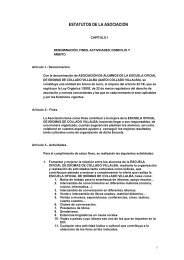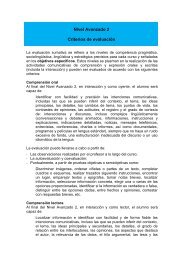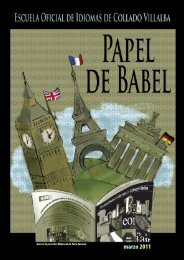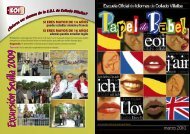Maquetación 1 - Escuela Oficial de Idiomas
Maquetación 1 - Escuela Oficial de Idiomas
Maquetación 1 - Escuela Oficial de Idiomas
Create successful ePaper yourself
Turn your PDF publications into a flip-book with our unique Google optimized e-Paper software.
FAMOUS QUIZ<br />
On February 24th, we saw a funny and crazy show: The<br />
Quiz about Famous People. It was presented by a<br />
showman and two teams had to answer questions about<br />
songs, films and celebrities. There were five fabulous prizes<br />
and the winners could win one of them.<br />
Finally the team named “You are the best” won a tour<br />
around Spain with the showman for a year.<br />
Congratulations to EOI Villalba and Andrew Marshall.<br />
Mariví Vicente Escu<strong>de</strong>ro. Inglés Nivel Básico 1<br />
In my opinion, the play was really funny! The showman<br />
was crazy and he danced very well. The people who<br />
participated in the performance were very<br />
embarrassed and that was very funny too.<br />
Lara Torija García. Inglés Nivel Intermedio 1<br />
On 24th February we saw a play called “Titanic: The<br />
Stage Play”, performed by Andrew Marshall.<br />
The plot was about a theatre company which had to<br />
perform a play about the sinking of the Titanic, but all<br />
the actors and actresses of the company abandoned<br />
the company Director just before the performance of<br />
that evening. The company director complained about<br />
the members of his company. Eva interpreted Rose in<br />
the play, and she was only worried about being goodlooking<br />
on the stage. Jeremy was gay and interpreted<br />
Jack, Rose’s boyfriend, but he looked more feminine<br />
than Rose. Another member of the company was<br />
Tommy, who ma<strong>de</strong> good use of being on the stage to<br />
pick up women, because he was a Romeo. And Lyn,<br />
who was Rose’s mother, was so creative that she<br />
changed the scenes when she wanted. It was a brilliant<br />
performance and an excellent play, full of ingenious<br />
14<br />
What a surprising day!<br />
LA ESCUELA �<br />
I had a good time, the actor involved the public in the<br />
action. It was a lively performance. I liked the character<br />
of the actor, so cheerful. I would like to watch more<br />
plays like this.<br />
Mariola Juan Martín. Inglés Nivel Intermedio 1<br />
I think it has been enjoyable and original. The man who<br />
acted, in different moments of the play looked a bit<br />
mad, however, in other moments he was funny, and his<br />
jokes were funny too.<br />
The actor seemed a bit clumsy, but he knew how to<br />
cheer the public and created the atmosphere of a TV<br />
programme.<br />
Yolanda García Llorente. Inglés Nivel Intermedio 1<br />
TITANIC<br />
“THE STAGE PLAY”<br />
gags. It was very funny. I think all of us who were there<br />
had a good time.<br />
Mª Rosa Rodríguez Pérez. Inglés Nivel Intermedio 2<br />
Looking at the man who was wearing some strange<br />
clothes. I could only wait to listen to his voice and see<br />
what he had to say, what he was going to do, what<br />
kind of things he had to show all of us. That voice trying<br />
to be an old woman ma<strong>de</strong> me smile and I thought there<br />
was something really interesting to watch, someone<br />
interesting to listen to in front of me. I have never known<br />
how much a smile costs, and I have always said that being<br />
able to make others laugh is not easy. Now I’m sure when<br />
you can manage a smile, you can also feel proud, because<br />
if you are able to put the right words together, you have<br />
not hurt anyone to reach your goals.<br />
Patricia Marzoa Alonso. Inglés Nivel Intermedio 2<br />
� AULA ABIERTA<br />
Aprendizajepor puestos<br />
Eva Bauer, profesora <strong>de</strong> alemán<br />
En este artículo queremos presentar la actividad que el <strong>de</strong>partamento <strong>de</strong> alemán llevó a<br />
cabo por navida<strong>de</strong>s y explicar en qué consiste el aprendizaje por puestos.<br />
Primero un poco <strong>de</strong> historia<br />
El aprendizaje por puestos no es un invento <strong>de</strong><br />
nuestros días. La pedagoga americana Helen Parkhurst<br />
utilizó esta forma <strong>de</strong> trabajo basándose en i<strong>de</strong>as <strong>de</strong><br />
María Montessori. En los años 80 vuelve a surgir en<br />
Alemania con el fin <strong>de</strong> variar el aprendizaje <strong>de</strong> la<br />
lectoescritura. A partir <strong>de</strong> ahí se empieza a difundir a<br />
varias asignaturas y contenidos.<br />
Un poco <strong>de</strong> teoría<br />
Características <strong>de</strong>l aprendizaje por puestos<br />
Atención a la Diversidad Trabajar en equipo Estrategías <strong>de</strong> Aprendizaje<br />
Enseñanza Abierta Aprendizaje por puestos<br />
Autonomía<br />
Apren<strong>de</strong>r con todos<br />
los sentidos<br />
Motivación<br />
Aprendizaje en el uso<br />
<strong>de</strong> la lengua<br />
¿En que consiste entonces el aprendizaje por puestos?<br />
Se elige un contenido que será dividido en varias<br />
partes. Para cada parte se busca material. Este material<br />
se ofrece a los alumnos que <strong>de</strong>berán trabajar con él <strong>de</strong><br />
forma autónoma. Por eso es muy importante que el<br />
material sea a<strong>de</strong>cuado al nivel <strong>de</strong> los alumnos. Dentro<br />
<strong>de</strong> ese nivel se pue<strong>de</strong>n incluir materiales un poco más<br />
exigentes junto a otros más sencillos para aten<strong>de</strong>r a la<br />
diversidad.<br />
El material se dispone en el aula en los distintos<br />
puestos. Los alumnos pasan por los distintos puestos y<br />
trabajan solos o en grupos.<br />
La actividad<br />
Les propusimos a los alumnos 7 puestos, todos tenían<br />
que ver con el tema <strong>de</strong> la Navidad. Tenían que or<strong>de</strong>nar<br />
textos, jugar a las cartas o i<strong>de</strong>ntificar dulces como se<br />
pue<strong>de</strong> apreciar en el gráfico. Les repartimos en grupos<br />
mixtos, es <strong>de</strong>cir que en cada grupo había alumnos <strong>de</strong><br />
distintos niveles. Así los alumnos más experimentados<br />
pudieron ayudar a alumnos principiantes.<br />
Cada puesto tenía un número y los alumnos<br />
disponían <strong>de</strong> una hoja informativa con los puestos<br />
que había que recorrer.<br />
Puesto 1:<br />
Comprensión oral:<br />
Rellenar huecos.<br />
Villancico<br />
Puesto 4:<br />
Costumbres:<br />
Juego <strong>de</strong> cartas<br />
“Bleigießen”<br />
Puesto 2:<br />
Vocabulario:<br />
juego <strong>de</strong> memoria<br />
y un crucigrama<br />
Puesto 5:<br />
Puzzle: Or<strong>de</strong>nar<br />
un texto<br />
navi<strong>de</strong>ño I<br />
Puesto 3:<br />
Comprensión lectora:<br />
Leer y contestar a preguntas<br />
Puesto 6:<br />
Todos los sentidos:<br />
Dulces navi<strong>de</strong>ños<br />
Puesto 7:<br />
Puzzle:<br />
Or<strong>de</strong>nar un texto<br />
navi<strong>de</strong>ño II<br />
En los distintos puestos los alumnos encontraron:<br />
• Instrucciones y material <strong>de</strong> trabajo, plastificado<br />
• Fichas para cada alumno.<br />
Una <strong>de</strong> las activida<strong>de</strong>s con más éxito fue la <strong>de</strong> i<strong>de</strong>ntificar<br />
dulces, dón<strong>de</strong> primero había que unir el nombre con el<br />
dulce. Después un alumno probó un dulce con los ojos<br />
cerrados mientras un compañero leyó los nombres en voz<br />
alta. Antes <strong>de</strong> quitarse la venda los alumnos tenían que<br />
nombrar el dulce que habían probado.<br />
Es importante incluir este tipo <strong>de</strong> tareas porque en el<br />
aprendizaje por puestos se quiere ir más allá <strong>de</strong>l<br />
aprendizaje cognitivo.<br />
También gustó mucho el juego <strong>de</strong> cartas “Bleigießen”.<br />
“Bleigießen“ es una costumbre que se realiza en noche<br />
vieja para pre<strong>de</strong>cir el futuro. En vez <strong>de</strong> fundir estaño,<br />
como se hace <strong>de</strong> verdad, nuestros alumnos<br />
interpretaron fotos con figuras ya fundidas. Des<strong>de</strong><br />
luego que a los alumnos <strong>de</strong> alemán les esperaba un<br />
año lleno <strong>de</strong> riquezas y aventuras amorosas.<br />
Realizar una actividad <strong>de</strong> este tipo exige bastante<br />
trabajo <strong>de</strong> preparación. Aún así estamos convencidos<br />
<strong>de</strong> que merece la pena porque repercute en una mayor<br />
motivación <strong>de</strong> los alumnos que aprendieron mucho<br />
más sobre la Navidad que en una clase “normal”.<br />
Fuentes:Fremdsprache Deutsch Heft 35/2006 – Lernen an<br />
Stationen, © Hueber Verlag<br />
15








